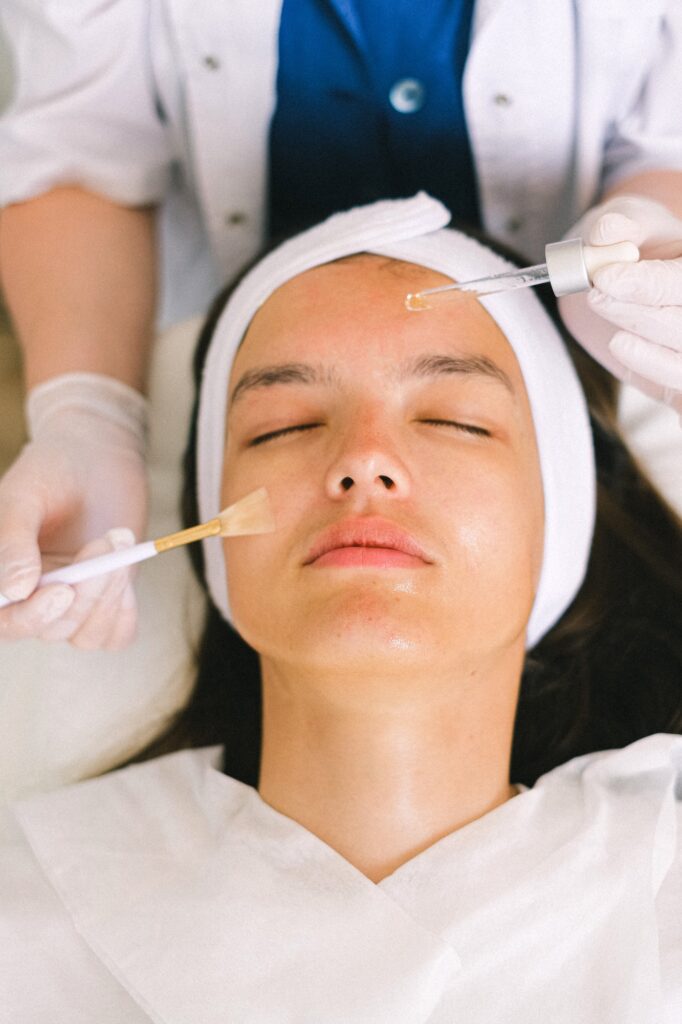
Two technologies dominate modern “hydradermabrasion”: HydraFacial and DiamondGlow. Both couple mechanical exfoliation with vacuum-assisted extraction and infusion of targeted serums. Think of them as synchronized “cleanse–clear–charge” systems: remove dull stratum corneum, evacuate compacted sebum, then drive actives into freshly receptive skin.
How HydraFacial changes skin biology
HydraFacial uses a spiral, vortex-generating tip that simultaneously exfoliates, suctions debris, and pneumatically delivers serums. In a randomized controlled trial of 20 women, six HydraFacial sessions (7–10 days apart) produced histologic gains—thicker epidermis and papillary dermis, replacement of elastotic tissue, higher fibroblast density—and raised cutaneous polyphenol levels. Clinically, fine lines, pore size, and dyschromia decreased without complications. The same antioxidant serum applied manually (no hydradermabrasion) failed to produce these changes, underscoring that the device-driven delivery matters. (PubMed)
If acne is your target, HydraFacial’s clarifying protocol (glycolic/salicylic prep, vacuum extraction, then blue LED) improved Global Acne Severity Scores in a 12-week multicenter study: the proportion of patients rated “clear or almost clear” rose from 20% at baseline to 65% after six treatments; patient self-ratings moved from 5% to 55%. Tolerability was high. (JCAD)
How DiamondGlow works—and where it shines
DiamondGlow (formerly SilkPeel Dermalinfusion) employs a diamond-coated tip to resurface while a controlled vacuum extracts and infuses condition-specific serums in one pass. Cleveland Clinic’s overview captures the mechanism succinctly: simultaneous exfoliation, extraction, and serum infusion; providers choose serums for hydration, brightening, congestion, or sensitivity. The key distinction from HydraFacial is the tip design (diamond vs. spiral), but both deliver the same three core actions. (Cleveland Clinic)
Clinical data around DiamondGlow-specific serums are growing. In an open-label study, biweekly DiamondGlow with an HA5 hyaluronic acid pro-infusion serum (plus at-home HA5) improved dryness, texture, dullness, and fine lines across instrumented and clinical measures over 12 weeks. (PubMed) In another prospective study, DiamondGlow paired with a growth-factor pro-infusion (and at-home TNS Advanced+) yielded immediate improvements in radiance and hydration after one session, with progressive gains in wrinkles and smoothness through week 12; tolerability scores remained under 1 (mild). (PubMed)
Fun (and useful) science bits you can feel
- Freshly exfoliated skin behaves like a sponge: removing compacted corneocytes and sebum lowers the barrier to diffusion so active molecules penetrate further—device-assisted infusion capitalizes on this window. High-resolution optical coherence tomography has even visualized micro-architectural changes after hydradermabrasion in vivo. (PMC)
- Polyphenols aren’t just a Mediterranean diet talking point; when delivered into skin by hydradermabrasion they can measurably rise in the tissue, coinciding with dermal remodeling in controlled trials. (PubMed)
Which one should you choose?
Mechanistically, both platforms exfoliate, extract, and infuse. Selection hinges on your indications, skin reactivity, and which serum ecosystem best targets your goals (e.g., acne and oil control protocols with HydraFacial; hydration and growth-factor or HA5 regimens with DiamondGlow). A physician-led plan often sequences them with other modalities (chemical peels, pigmentsafe lasers, topical retinoids) to amplify outcomes and reduce downtime.
Our Hada Cosmetic Medicine approach
We treat these technologies like instruments in an orchestra, not one-off services. You’ll see:
• Physician-directed protocols: We match device settings and serums to your Fitzpatrick type, barrier status, and inflammatory load, then integrate evidence-based topicals between visits so gains consolidate rather than fade. The clinical acne data above inform our clarifying series timing; the growth-factor and HA5 studies guide our hydration and rejuvenation tracks. (JCAD)
• Measurable endpoints: We document with standardized photography and, when useful, noninvasive instrumentation (hydration, pigmentation indices) so you can see objective changes session to session—mirroring how the trials reported outcomes. (PubMed)
• Skin-of-color nuance: Many of our protocols prioritize pigment-safe, low-irritation parameters and brightening infusions to respect melanocyte reactivity while still addressing texture and congestion noted in the literature. (Cleveland Clinic)
• Combination care: We pair hydradermabrasion with retinoid literacy, sunscreen adherence, and microbiome-sparing cleansers so results persist past the glow.
What you can expect in clinic
HydraFacial clarifying: ideal if breakouts or oil are front and center. Expect a clean-pore “reset,” often with visible lesion count improvement by visit three, in line with the acne study’s biweekly cadence. (JCAD)
DiamondGlow rejuvenation: best when dehydration, fine rhytids, or dullness lead the problem list; HA5 or growth-factor infusions layer hydration and signaling, with immediate radiance after one session and cumulative improvements across 6 visits. (PubMed)
Bottom line
HydraFacial and DiamondGlow at Hada aren’t spa facials; they are controlled resurfacing and drug-delivery platforms, they are a medical grade procedure. Trials demonstrate structural and clinical gains—from thicker, healthier epidermis and dermis to clearer acne and better hydration—when protocols are executed correctly and paired with at-home regimens. We bring the medical reasoning, device nuance, and outcome tracking to make that evidence serve your specific skin.
If you’re ready for a plan built like a treatment algorithm, not a menu, book a consult at Hada Cosmetic Medicine and we’ll map the right series for your skin and schedule.

